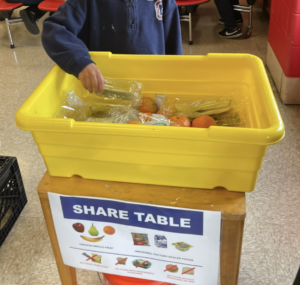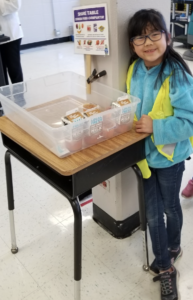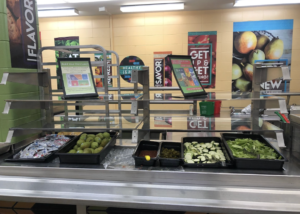 At the most recent Wasted Food Action Alliance meeting held on August 28, SGA’s Zero Waste Schools team presented about share tables and Offer vs. Serve (OVS) to a group of food waste reduction enthusiasts. While the strategies presented were school-specific, they can be adapted to a variety of institutional kitchen and cafeteria settings.
At the most recent Wasted Food Action Alliance meeting held on August 28, SGA’s Zero Waste Schools team presented about share tables and Offer vs. Serve (OVS) to a group of food waste reduction enthusiasts. While the strategies presented were school-specific, they can be adapted to a variety of institutional kitchen and cafeteria settings.
Share tables provide an opportunity for uneaten packaged food, whole fruit, or milk from the school meal to be eaten by other students during the same meal period, given to students at another time (after school snack, for example), or to be donated. Having a plan for the surplus food is key since there will inevitably be food left on the share table at the end of each day.
 OVS prevents waste by giving students a choice of which meal components they would like to eat. The ZWS team stressed that while students must take a fruit or a vegetable, milk is not required. They shared the policy that supports this idea, as well as others regarding OVS and share tables and best practices to make them a success, including food safety considerations, training for staff, and clear signage in the cafeteria.
OVS prevents waste by giving students a choice of which meal components they would like to eat. The ZWS team stressed that while students must take a fruit or a vegetable, milk is not required. They shared the policy that supports this idea, as well as others regarding OVS and share tables and best practices to make them a success, including food safety considerations, training for staff, and clear signage in the cafeteria.
During the Q&A, the ZWS team shared that the team’s work is grant funded, but if a school doesn’t have funding available, they can still set up a call to support schools on their zero waste journey. In response to a question about managing staff turnover and what to do if a school loses its zero waste champions, they stressed the importance of operationalizing and institutionalizing these programs, so their longevity isn’t dependent on individual staff. 
For more information and resources, visit SGA’s Zero Waste Schools page where you can find a zero waste schools toolkit and a share table toolkit. Additionally, ISBE and the USDA have a variety of materials to support schools participating in OVS.
